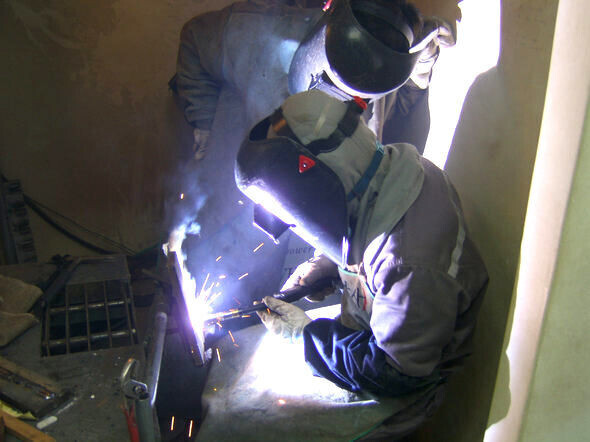hankyoreh
Links to other country sites 다른 나라 사이트 링크
S. Korea’s workforce is aging faster than its competitors’

South Korea’s manufacturing workforce is aging faster than its counterparts in two other major manufacturing powers, the US and Japan, an analysis shows.
The Korea Economic Research Institute (KERI) published a report Monday on “aging trends among manufacturing industry workers.” The figures showed that the percentage of manufacturing industry workers aged 50 and up rose from 15.7% in 2010 to 30.1% in 2020.
The analysis was based on a Ministry of Employment and Labor (MOEL) survey of the employment situation by job type.
Over the same period, the percentage of manufacturing industry workers in their 30s dropped from 35.1% to 27.8%, while the percentage aged 15 to 29 fell from 21.6% to 15.2%. The percentage in their 40s also dipped from 27.7% to 26.9%.
The manufacturing workforce aging trend in South Korea was far outpacing similar trends in the US and Japan. The average age of manufacturing workers in South Korea rose by 3.3 years from 39.2 to 42.5 since 2011. Over the same period, Japan’s average age rose by 1.2 years from 41.6 to 42.8, while the US’ average age rose by 0.3 years from 44.1 to 44.4.
In terms of the average annual rate of increase, South Korea’s level was 0.90%, far higher than the 0.08% recorded for the US and the 0.32% recorded for Japan.
“If the current trend continues, the average age of South Korean manufacturing industry workers will reach 44.9 by 2026, putting it ahead of the US (44.6) and Japan (43.6),” the KERI said.
The institute said that the aging trend in manufacturing could not be attributed simply to the “overall population aging trend with a low birthrate.”
“Current regular workers are overprotected by various company regulations and strict labor controls, and with manufacturing investment and hiring in decline, it has become more difficult for younger people to enter the labor market,” it added.
An analysis of salary trends by age groups showed that average monthly waves for workers aged 50 and older increased by an average of 4.6% per year from 2,607,000 won (US$2,236) in 2010 to 4,096,000 won (US$3,514) in 2020. In contrast, the rises were just 3.6% for workers under 30, 3.3% for those in their 40s, and 2.5% for those in their 30s.
The KERI attributed the faster rate of increase in salary among older workers to pay grade systems in which wages rise with the number of years spent at a job, regardless of productivity. The institute cited MOEL figures as showing that 54.9% of workplaces with 100 or more employees had instituted pay grade systems as of 2020.
“The aging trend in manufacturing has weakened growth drivers, reducing industry and national competitiveness and worsening income polarization between generations and poverty among young people,” said Chu Gwang-ho, director of the KERI economic policy department.
By Kim Young-bae, senior staff writer
Please direct comments or questions to [english@hani.co.kr]

Editorial・opinion
![[Column] Has Korea, too, crossed the Rubicon on China? [Column] Has Korea, too, crossed the Rubicon on China?](https://flexible.img.hani.co.kr/flexible/normal/500/300/imgdb/original/2024/0419/9317135153409185.jpg) [Column] Has Korea, too, crossed the Rubicon on China?
[Column] Has Korea, too, crossed the Rubicon on China?![[Correspondent’s column] In Japan’s alliance with US, echoes of its past alliances with UK [Correspondent’s column] In Japan’s alliance with US, echoes of its past alliances with UK](https://flexible.img.hani.co.kr/flexible/normal/500/300/imgdb/original/2024/0419/2317135166563519.jpg) [Correspondent’s column] In Japan’s alliance with US, echoes of its past alliances with UK
[Correspondent’s column] In Japan’s alliance with US, echoes of its past alliances with UK- [Editorial] Does Yoon think the Korean public is wrong?
- [Editorial] As it bolsters its alliance with US, Japan must be accountable for past
- [Guest essay] Amending the Constitution is Yoon’s key to leaving office in public’s good graces
- [Editorial] 10 years on, lessons of Sewol tragedy must never be forgotten
- [Column] A death blow to Korea’s prosecutor politics
- [Correspondent’s column] The US and the end of Japanese pacifism
- [Guest essay] How Korea turned its trainee doctors into monsters
- [Guest essay] As someone who helped forge Seoul-Moscow ties, their status today troubles me
Most viewed articles
- 1[Column] The clock is ticking for Korea’s first lady
- 2Hong Se-hwa, voice for tolerance whose memoir of exile touched a chord, dies at 76
- 3After 2 months of delayed, denied medical care, Koreans worry worst may be yet to come
- 4[Column] Has Korea, too, crossed the Rubicon on China?
- 5US overtakes China as Korea’s top export market, prompting trade sanction jitters
- 6Samsung barricades office as unionized workers strike for better conditions
- 7[Correspondent’s column] In Japan’s alliance with US, echoes of its past alliances with UK
- 8All eyes on Xiaomi after it pulls off EV that Apple couldn’t
- 9[Correspondent’s column] The US and the end of Japanese pacifism
- 10[Guest essay] How Korea turned its trainee doctors into monsters